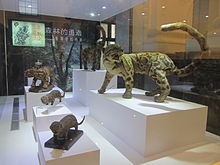Formosan clouded leopard
| Formosan clouded leopard | |
|---|---|
![Drawing of a Formosan clouded leopard published in 1862[1]](http://upload.wikimedia.org/wikipedia/commons/thumb/2/21/LeopardusBrachyurusWolf.jpg/220px-LeopardusBrachyurusWolf.jpg)
| |
| Drawing of a Formosan clouded leopard published in 1862[1] | |
| Scientific classification | |
| Domain: | Eukaryota |
| Kingdom: | Animalia |
| Phylum: | Chordata |
| Class: | Mammalia |
| Order: | Carnivora |
| Suborder: | Feliformia |
| Family: | Felidae |
| Subfamily: | Pantherinae |
| Genus: | Neofelis |
| Species: | N. nebulosa |
| Population: | †Formosan clouded leopard |
| Synonyms | |
| |
The Formosan clouded leopard is a
Taxonomy
Felis nebulosa was the
It was later considered the clouded leopard
Characteristics

It was first described in 1862 on the basis of a traded skin with an incomplete tail. Its fur colour is pale to tawny, and it has large cloud-like markings on the shoulders and flanks with a few spots within the clouds.
Last efforts

An interview survey conducted in 1986 among 70
It has been assumed that clouded leopards retreated into the
Between 1997 and 2012, camera trapping surveys were conducted in more than 1,450 sites in potentially suitable habitats across Taiwan, from the seashore to an elevation of 3,796 m (12,454 ft), in fragmented lowlands and inside protected areas.
Alleged sightings
In the summer of 2018, two different groups of rangers allegedly sighted a clouded leopard in Taitung County. One group claimed to have seen an individual climbing a tree and hunting goats on a cliff. The other group contended to have observed an individual darting past a scooter on a road and climbing into a tree.[13][14]
Cultural influence
The clouded leopard is highly respected by the Rukai people culture who believe that their ancestors followed a clouded leopard to their ancestral land.[15] They consider the hunting of clouded leopards a taboo.[16] In Paiwan culture, the pelt of clouded leopard can only be worn by the nobility.[17]
In both cultures, it is believed that the clouded leopard and the Formosan black bear are originally white, until one day they decided to paint each other. The bear meticulously painted the leopard with exquisite patterns. The clouded leopard painted the bear all black, except for the V-shaped area before the chest, which remained white for various reasons depending on the version of the story. As an apology for the bad work, now the clouded leopards only eat a part of their prey, leaving the rest for the bear.[18]
The
See also
References
- ^ a b c d Swinhoe, R. (1862). "On the Mammals of the Island of Formosa". Proceedings of the Zoological Society of London: 348–365.
- ^ . Retrieved 19 November 2021.
- ^ a b Kitchener, A. C.; Breitenmoser-Würsten, C.; Eizirik, E.; Gentry, A.; Werdelin, L.; Wilting, A.; Yamaguchi, N.; Abramov, A. V.; Christiansen, P.; Driscoll, C.; Duckworth, J. W.; Johnson, W.; Luo, S.-J.; Meijaard, E.; O’Donoghue, P.; Sanderson, J.; Seymour, K.; Bruford, M.; Groves, C.; Hoffmann, M.; Nowell, K.; Timmons, Z. & Tobe, S. (2017). "A revised taxonomy of the Felidae: The final report of the Cat Classification Task Force of the IUCN Cat Specialist Group" (PDF). Cat News (Special Issue 11): 64.
- ^ a b c d Chiang, P.-J. (2007). Ecology and Conservation of the Formosan clouded leopard, its prey, and other sympatric carnivores in southern Taiwan (PDF) (PhD). Blacksburg, Virginia: Virginia Polytechnic Institute and State University.
- ^ .
- .
- PMID 17141620.
- ^ S2CID 6838593.
- .
- ^ Anonymous (1996). "The mystery of the Formosan clouded leopard". Cat News (24): 16.
- ^ Lue, K. Y.; Chang, W. S.; Hwa, B. Z. (1992). The Faunal Investigation on Yu-Li Wildlife Nature Reserve. Report 79-02. Taipei: Taiwan Forest Bureau Conservation and Research.
- ^ Wang, Y.; Chen, Y.; Lai, C. (1996). Wildlife population study and monitor at Nan-Tzy-Shian River watershed area. Taipei: Conservation and Planning Administration, Ministry of Interior, Taiwan.
- ^ Everington, K. (2019). "'Extinct' Formosan clouded leopard spotted in E. Taiwan". Taiwan News.
- ^ Hoffner, E. (2019). "Taiwan: Extinct leopard subspecies allegedly seen by rangers". Mongabay. Retrieved 2019-03-04.
- ^ "Rukai Mythology" (in Chinese). Ministry of Culture, ROC. Retrieved 2021-03-27.
- ^ Pei, K. (1999). Hunting System of the Rukai Tribe in Taiwan, Republic of China. Proceedings of the International Union of Game Biologists XXIV Congress. Thessaloniki, Greece.
- ^ "追尋雲豹的腳蹤". Our Island (in Chinese). Vol. 250. Public Television Service. 2004. Archived from the original on 2021-12-22.
- ^ "雲豹的故鄉--大武山" (in Chinese). Public Television Service. 2004.

